Abstract
Difficulty in the diagnosis of the disease scleroderma may occur at the early stage prior to the development of obvious skin sclerosis. A presumptive diagnosis may be made if Raynaud's phenomenon is accompanied by a positive 'neck test', 'scleroderma' capillary changes in the nailfolds or antinuclear antibodies. Definitive diagnosis may have to be delayed for several years from the onset of Raynaud's phenomenon until definite characteristic skin changes are seen. Ten cases in which an earlier diagnosis of scleroderma was not substantiated are listed. The earlier incorrect diagnosis would have been avoided by use of the methods described in this paper. Various terms have been used to denote subdivisions of scleroderma. These include acrosclerosis, diffuse scleroderma and CREST. We have used the terms Type 1, Type 2 and Type 3 based on the early extent of the skin sclerosis where Type 1 (limited extent) indicates sclerodactyly only, Type 2 (moderate extent) indicates sclerosis proximal to the metacarpophalangeal joints but excluding the trunk and Type 3 (extensive) indicates diffuse skin sclerosis including the trunk. The clinical value of this simple classification is reviewed and contrasted to other classifications which appear to be poorly defined and of limited use.
Full text
PDF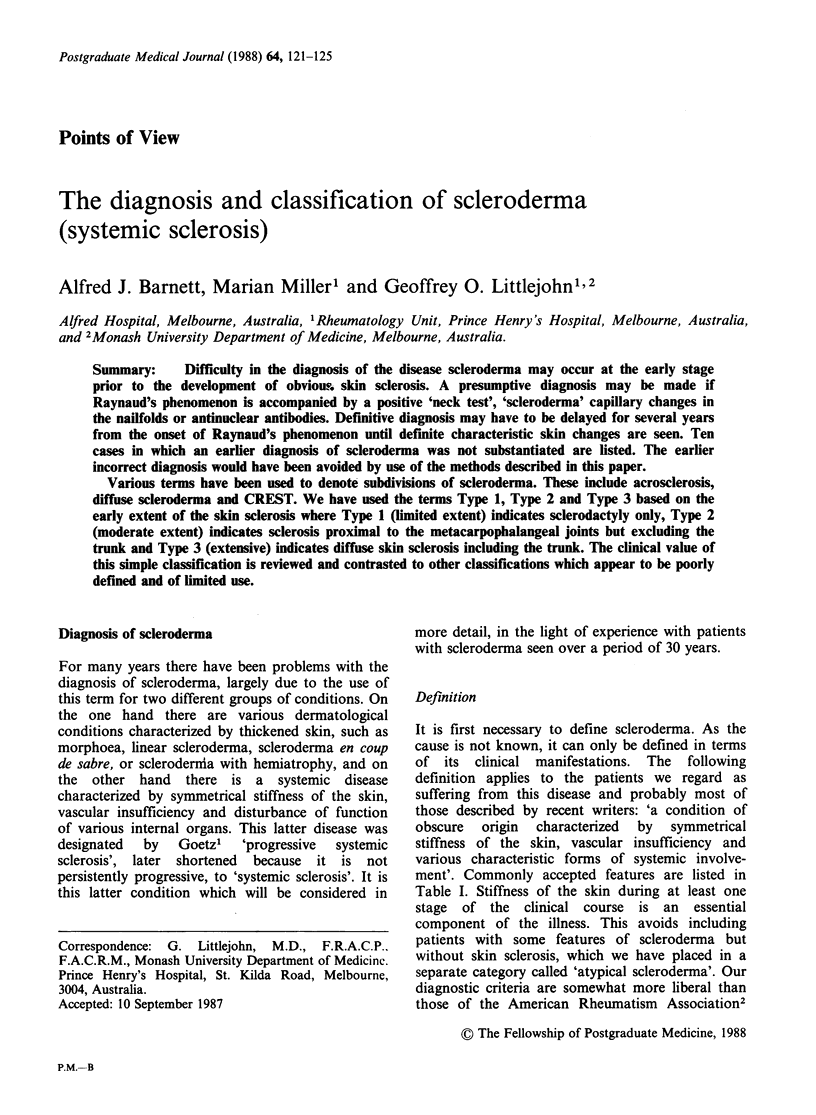
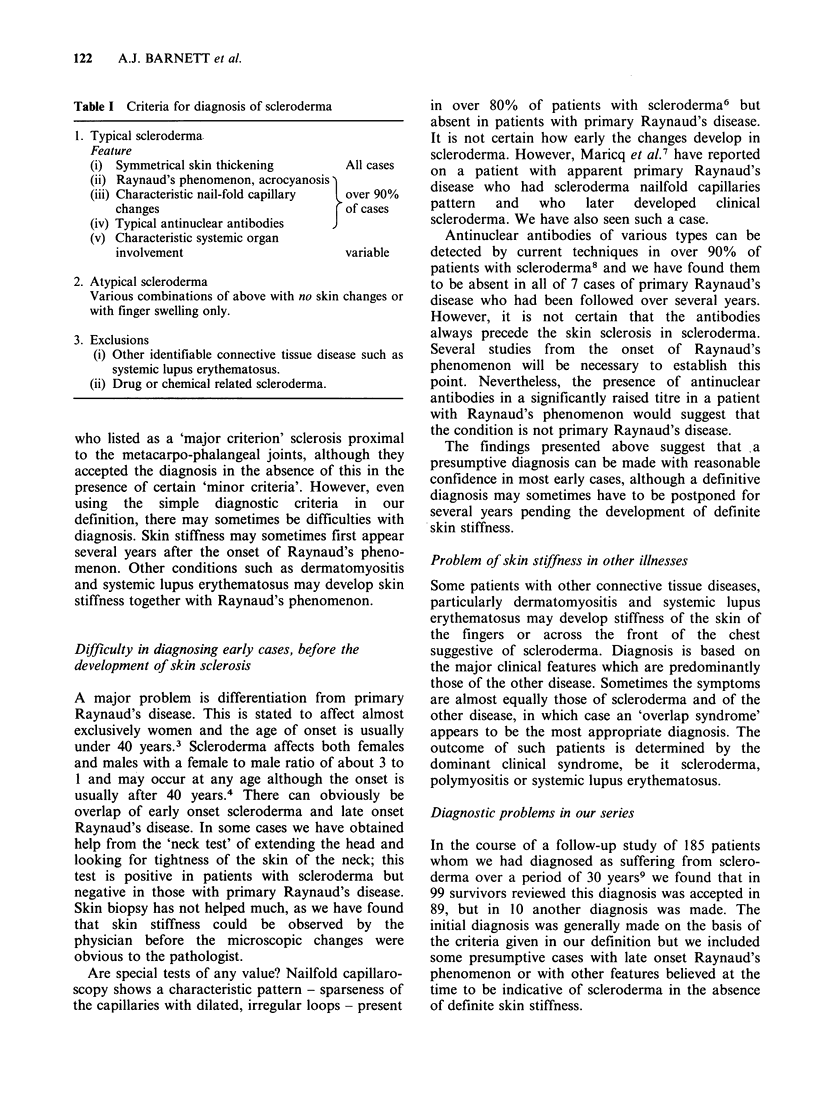
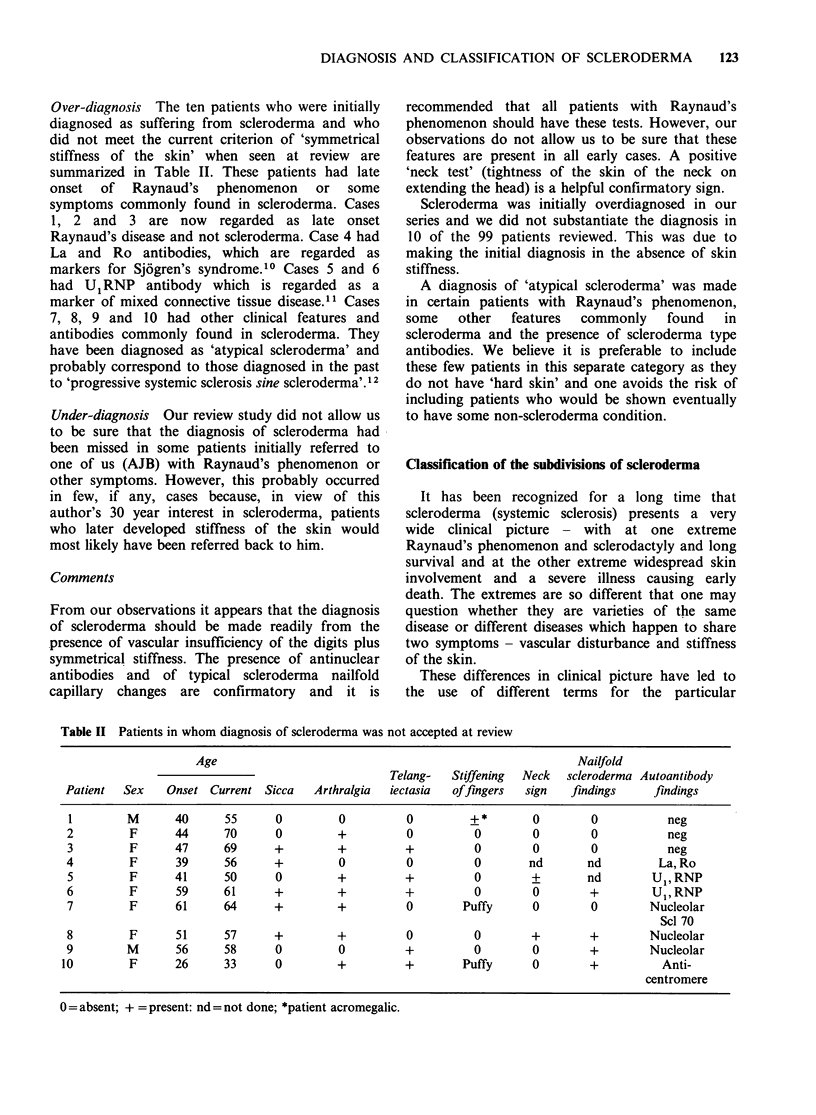
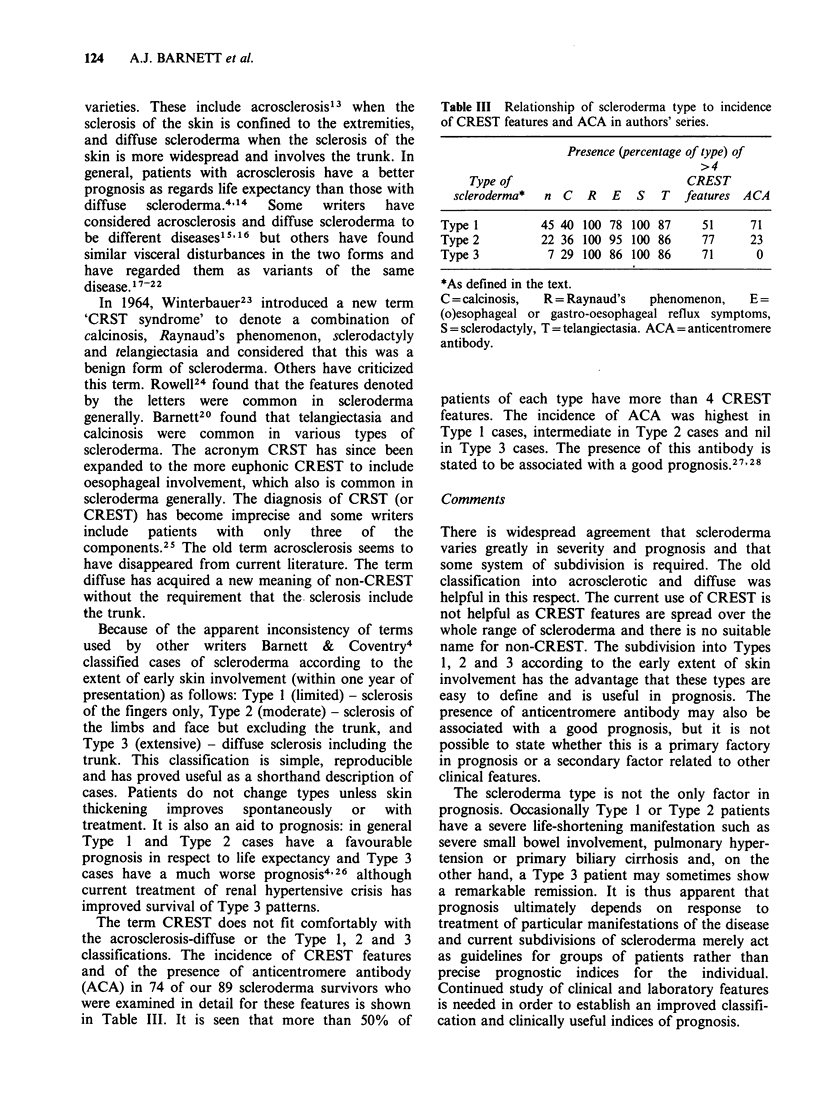
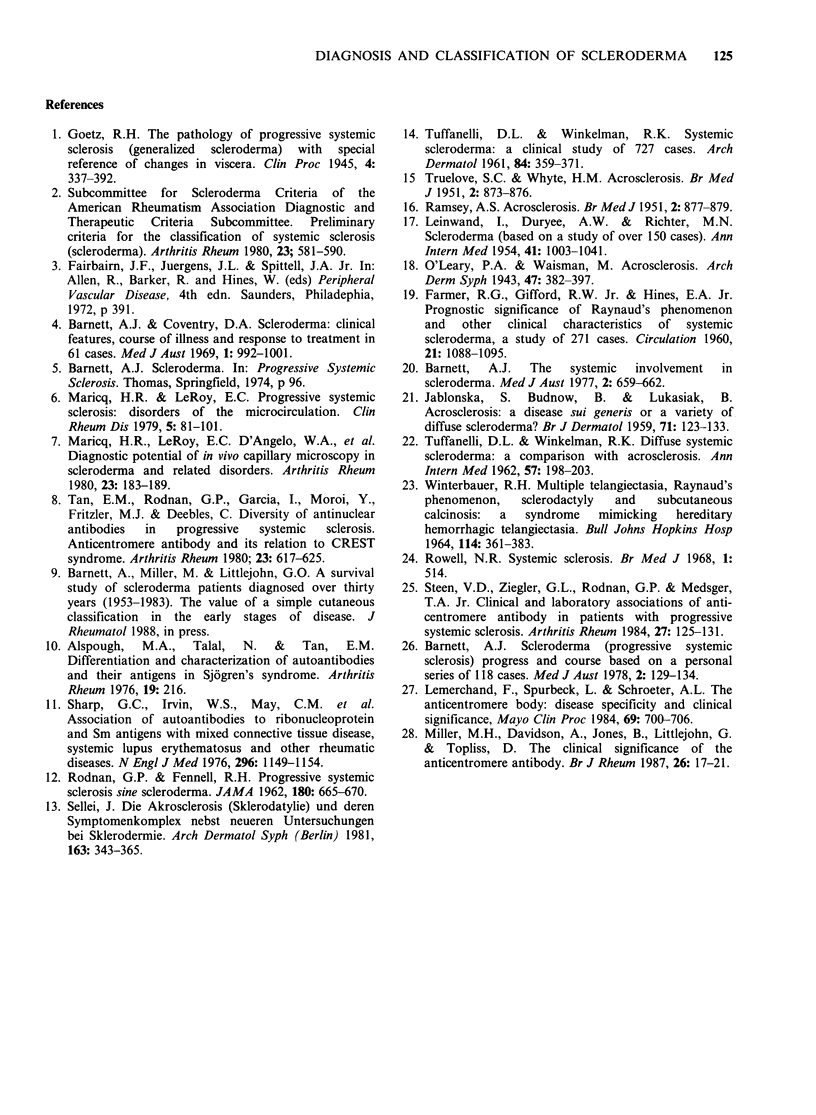
Selected References
These references are in PubMed. This may not be the complete list of references from this article.
- Alspaugh M. A., Talal N., Tan E. M. Differentiation and characterization of autoantibodies and their antigens in Sjögren's syndrome. Arthritis Rheum. 1976 Mar-Apr;19(2):216–222. doi: 10.1002/art.1780190214. [DOI] [PubMed] [Google Scholar]
- Barnett A. J., Coventry D. A. Scleroderma. 1. Clinical features, course of illness and response to treatment in 61 cases. Med J Aust. 1969 May 10;1(19):992–1001. doi: 10.5694/j.1326-5377.1969.tb49844.x. [DOI] [PubMed] [Google Scholar]
- Barnett A. J. Scleroderma (progressive systemic sclerosis): progress and course based on a personal series of 118 cases. Med J Aust. 1978 Aug 12;2(4):129–134. doi: 10.5694/j.1326-5377.1978.tb131413.x. [DOI] [PubMed] [Google Scholar]
- Barnett A. J. The systemic involvement in scleroderma. Med J Aust. 1977 Nov 12;2(20):659–662. doi: 10.5694/j.1326-5377.1977.tb99196.x. [DOI] [PubMed] [Google Scholar]
- FARMER R. G., GIFFORD R. W., Jr, HINES E. A., Jr Prognostic significance of Raynaud's phenomenon and other clinical characteristics of systemic scleroderma. A study of 271 cases. Circulation. 1960 Jun;21:1088–1095. doi: 10.1161/01.cir.21.6.1088. [DOI] [PubMed] [Google Scholar]
- JABLONSKA S., BUBNOW B., LUKASIAK B. Acrosclerosis: a disease sui generis or a variety of diffuse scleroderma. Br J Dermatol. 1959 Apr;71(4):123–133. doi: 10.1111/j.1365-2133.1959.tb13397.x. [DOI] [PubMed] [Google Scholar]
- LEINWAND I., DURYEE A. W., RICHTER M. N. Scleroderma; based on a study of over 150 cases. Ann Intern Med. 1954 Nov;41(5):1003–1041. doi: 10.7326/0003-4819-41-5-1003. [DOI] [PubMed] [Google Scholar]
- Maricq H. R., LeRoy E. C., D'Angelo W. A., Medsger T. A., Jr, Rodnan G. P., Sharp G. C., Wolfe J. F. Diagnostic potential of in vivo capillary microscopy in scleroderma and related disorders. Arthritis Rheum. 1980 Feb;23(2):183–189. doi: 10.1002/art.1780230208. [DOI] [PubMed] [Google Scholar]
- Miller M. H., Littlejohn G. O., Davidson A., Jones B., Topliss D. J. The clinical significance of the anticentromere antibody. Br J Rheumatol. 1987 Feb;26(1):17–21. doi: 10.1093/rheumatology/26.1.17. [DOI] [PubMed] [Google Scholar]
- Powell F. C., Winkelmann R. K., Venencie-Lemarchand F., Spurbeck J. L., Schroeter A. L. The anticentromere antibody: disease specificity and clinical significance. Mayo Clin Proc. 1984 Oct;59(10):700–706. doi: 10.1016/s0025-6196(12)62059-x. [DOI] [PubMed] [Google Scholar]
- RAMSEY A. S. Acrosclerosis. Br Med J. 1951 Oct 13;2(4736):877–879. doi: 10.1136/bmj.2.4736.877. [DOI] [PMC free article] [PubMed] [Google Scholar]
- RODNAN G. P., FENNELL R. H., Jr Progressive systemic sclerosis sine scleroderma. JAMA. 1962 May 26;180:665–670. doi: 10.1001/jama.1962.03050210027006. [DOI] [PubMed] [Google Scholar]
- Sharp G. C., Irvin W. S., May C. M., Holman H. R., McDuffie F. C., Hess E. V., Schmid F. R. Association of antibodies to ribonucleoprotein and Sm antigens with mixed connective-tissue disease, systematic lupus erythematosus and other rheumatic diseases. N Engl J Med. 1976 Nov 18;295(21):1149–1154. doi: 10.1056/NEJM197611182952101. [DOI] [PubMed] [Google Scholar]
- Steen V. D., Ziegler G. L., Rodnan G. P., Medsger T. A., Jr Clinical and laboratory associations of anticentromere antibody in patients with progressive systemic sclerosis. Arthritis Rheum. 1984 Feb;27(2):125–131. doi: 10.1002/art.1780270202. [DOI] [PubMed] [Google Scholar]
- TRUELOVE S. C., WHYTE H. M. Acrosclerosis. Br Med J. 1951 Oct 13;2(4736):873–876. doi: 10.1136/bmj.2.4736.873. [DOI] [PMC free article] [PubMed] [Google Scholar]
- TUFFANELLI D. L., WINKELMANN R. K. Diffuse systemic scleroderma. A comparison with acrosclerosis. Ann Intern Med. 1962 Aug;57:198–203. doi: 10.7326/0003-4819-57-2-198. [DOI] [PubMed] [Google Scholar]
- TUFFANELLI D. L., WINKELMANN R. K. Systemic scleroderma, A clinical study of 727 cases. Arch Dermatol. 1961 Sep;84:359–371. doi: 10.1001/archderm.1961.01580150005001. [DOI] [PubMed] [Google Scholar]
- Tan E. M., Rodnan G. P., Garcia I., Moroi Y., Fritzler M. J., Peebles C. Diversity of antinuclear antibodies in progressive systemic sclerosis. Anti-centromere antibody and its relationship to CREST syndrome. Arthritis Rheum. 1980 Jun;23(6):617–625. doi: 10.1002/art.1780230602. [DOI] [PubMed] [Google Scholar]
- WINTERBAUER R. H. MULTIPLE TELANGIECTASIA, RAYNAUD'S PHENOMENON, SCLERODACTYLY, AND SUBCUTANIOUS CALCINOSIS: A SYNDROME MIMICKING HEREDITARY HEMORRHAGIC TELANGIECTASIA. Bull Johns Hopkins Hosp. 1964 Jun;114:361–383. [PubMed] [Google Scholar]


